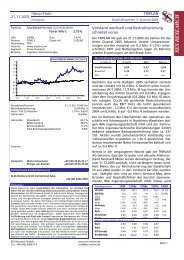ANNUAL REPORT 2006 - Triplan AG
ANNUAL REPORT 2006 - Triplan AG
ANNUAL REPORT 2006 - Triplan AG
You also want an ePaper? Increase the reach of your titles
YUMPU automatically turns print PDFs into web optimized ePapers that Google loves.
Consolidated Notes 41<br />
Other short-term provisions<br />
A provision is only reported if the company faces a current (statutory or factual) obligation due to a past event,<br />
it is likely that fulfilling that obligation will result in an outflow of resources and the amount of the obligation<br />
can be reliably calculated. Provisions are reviewed at each reporting date and adjusted in line with the best<br />
estimate at the time. If a significant interest-rate effect results from the date on which a commitment is met,<br />
the provision is included in the balance sheet at its present value. To the extent that no reliable estimate can<br />
be made in individual cases, no provision is made but a contingent liability is stated.<br />
Liabilities<br />
After being reported for the first time, all financial liabilities that are not derivative liabilities are measured at<br />
amortized historical costs. Once they have been reported for the first time, derivative liabilities are measured<br />
at their current market value.<br />
Realization of revenues<br />
Revenues are recorded if it is likely that the economic benefit associated with the corresponding transaction<br />
will be passed to the company in receipt of the service and if the amount of the revenues can be reliably<br />
measured. Sales revenues are recorded minus general sales tax and any price reductions/volume discounts<br />
provided that the delivery has been made and economic ownership together with the related risks and rewards<br />
has been transferred.<br />
Revenue from long-term orders is reported in accordance with IAS 18 Revenue or IAS 11 Construction Contracts<br />
according to the project’s effective progress (“percentage of completion method”, PoC). Gains from the PoC<br />
method are only recognized when the result of a production order can be reliably predicted. Since the results<br />
of production orders cannot be reliably predicted, revenues are reported in the amount of the expenses incurred<br />
(zero profit method).<br />
Interest<br />
Interest is recorded in line with the effective interest received on assets.<br />
Foreign currencies<br />
Foreign currency transactions are recorded in the reporting currency by translating the foreign currency amount<br />
on the basis of the exchange rate between the reporting and foreign currency at the time of the transaction.<br />
Translation differences from the settlement of monetary items at rates that differ from the rate originally<br />
recorded during the period are charged to expenses or income for the period in which they occur.<br />
Foreign commercial operations<br />
The subsidiaries in the group of consolidated companies are independent financially, economically and<br />
organizationally. They are therefore viewed as economically independent foreign units. Their reporting currency<br />
in each case is their national currency. The balance sheets prepared by the consolidated foreign holdings are<br />
translated using the year-end exchange rate; the income statements are translated using the average rate for<br />
the financial year. All resulting translation differences are included in the accumulated exchange rate differences<br />
within shareholders’ equity.<br />
Borrowing costs<br />
Borrowing costs are not capitalized but expensed in the period in which they are incurred. The interest rate risk<br />
based on the short-term loan liabilities in the Group and an interest rate change of +/– 1% is approximately<br />
¤ 1,000. Long-term loan liabilities have fixed interest rates.





